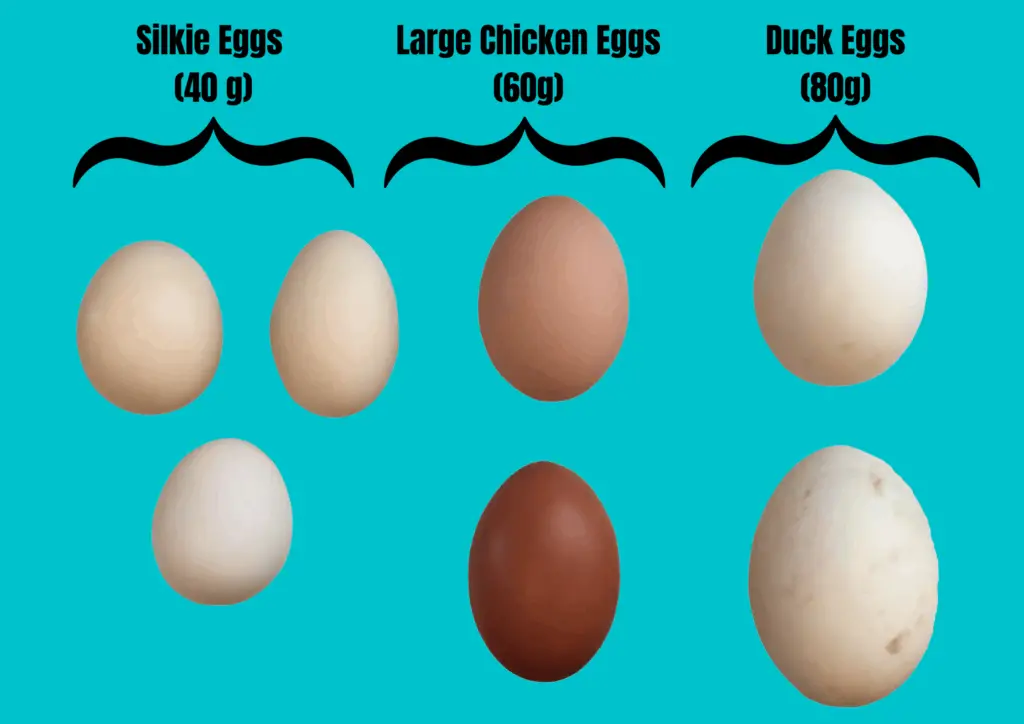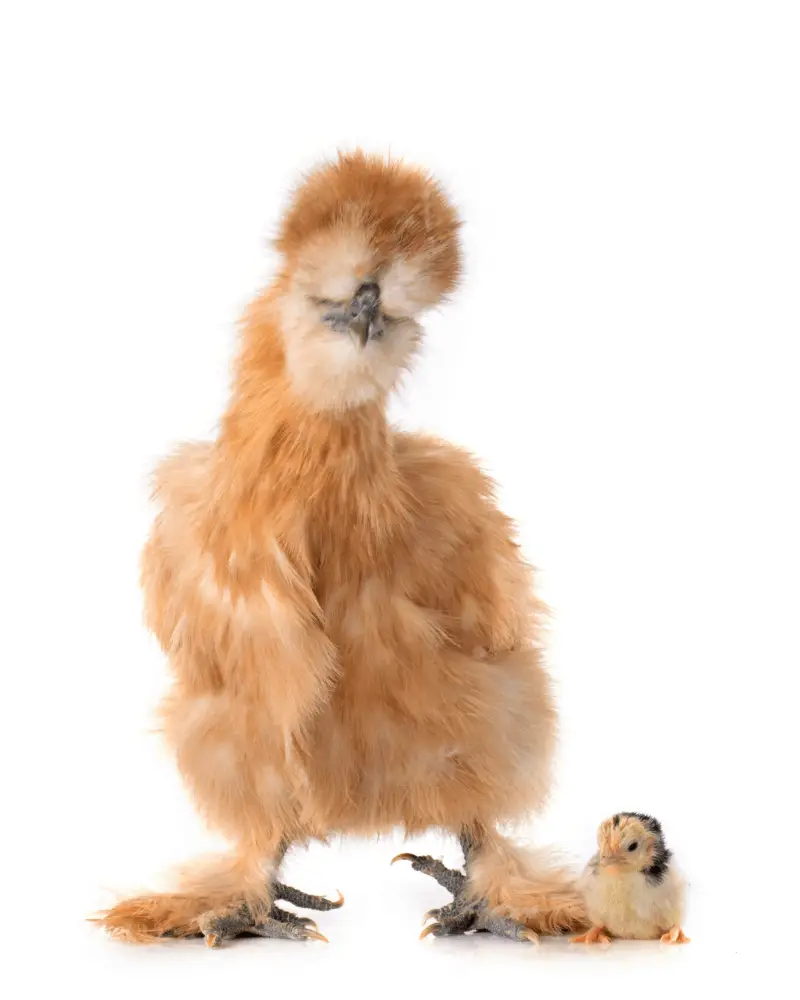Silkies are a popular backyard ornamental breed. What if I told you they can be used as egg producers as well? There are few things better than having eggs straight from your backyard for breakfast!
Silkie chicken eggs can be consumed like any other chicken egg. The hens start laying eggs around 7-9 months and can lay around 100 eggs per year. The eggs are small at approximately 40 grams an egg and are nutritionally denser compared to regular chicken eggs.
In this article, we compare silkies to commercial layer hens in egg production and give you a few tips on how to get the most of your backyard silkies in the egg-laying department.

Can You Eat Silkie Chicken Eggs?
Silkie chickens can be consumed just like any other chicken egg. They are approximately half the size of regular chicken eggs but can contain more vitamin B2, B6, D, E, calcium, potassium, and fat per gram off egg compared to commercial chicken eggs.
Because of their small size, they make wonderful snacks for children and due to the larger yolk to egg ratio, many people, myself included, consider silkie eggs tastier than store-bought commercial layer eggs.
Can You Eat Fertilized Silkie Chicken Eggs?
Fertilized Silkie chicken eggs can be consumed like any other chicken egg. If a fertilized egg is stored in the fridge soon after laying, the embryo will no longer grow and it will be barely noticeable.
A fertilized egg will have a small white disc on top of the yolk. It does not have any negative effect or benefit to eat a fertilized egg.
If you keep a rooster along with your hens, chances are, you will end up with a few fertilized eggs in the mix, but do not worry, if you collect the eggs daily and keep them in the fridge, there will be no harm to any chicken.
How Many Eggs Does a Silkie Chicken Lay?
Silkie chickens will start laying at about 7 – 9 months old. A broody silkie hen will produce an average of 2 eggs per week, 100 eggs per year, and about 300 eggs in her lifetime. This is less than layer chicken breeds such as the Australorp or Lohman Brown, which can produce up to 500 eggs per lifetime. Silkies have a longer life span and will therefore be productive for a longer time period.
Silkie Chickens vs. Commercial Layer Hens for Egg Production
| Parameter | Silkie Chickens | Commercial Layer Hens |
| Age start Laying | 7 – 9 months (some up to 12 months) | 4 – 5 months |
| Eggs per year | 90 – 120 | 200 – 250 |
| Eggs per lifetime | 300 – 400 | 500 – 600 |
| Egg size | 35 – 45 g (1.25 – 1.5 oz) | 55 – 65 g (1.75 – 2.3 oz) |
| Nutritional Value | Higher in Vitamin B2, B6, D, E, calcium, and Potassium per gram. Larger egg yolk to white ratio* | Higher in protein and lower in fat, cholesterol, and some vitamins per gram* |
| Color | Cream or off-white | Anything from white to brown, depending on breed |
| Incubation time for fertilized eggs | 19 – 20 days | 21 – 22 days |
| Lifespan | 8-10 years | 4 – 6 years for backyard layers (battery hens are culled at three years old) |
Visual Comparison of Silkie Eggs, Large Layer Hen Eggs and Duck Eggs

Keeping Silkie chickens for eggs
Silkie eggs are approximately half the size of large regular chicken eggs. They produce approximately 4 times less in their lifetime as compared to layer chicken breeds if considering weight and quantity of eggs produced.
You might not be able to satisfy your household egg needs entirely with just a few backyard silkies, but it is lovely to be able to serve up backyard eggs once in a while.
Silkies also do not produce eggs consistently as they go broody very often and love to incubate eggs. Heck, they love it some much, I have seen silkies sitting on a rock in a pot plant. They are wonderful brooders and will try to hatch anything. For this reason, that they are often utilized as brooders to hatch any other type of bird egg.
The Broody Silkie Hen
Silkie hens will go broody at least once a year or after laying 10-30 eggs and can go broody up to 4 times a year. They will stop laying eggs when they are broody and will sit for at least 3 weeks. Many broody hens will not lay eggs for up to 6 weeks after this. A hen does not need a rooster or fertilized eggs to go broody.
This makes them less ideal layers, but excellent incubators and mothers. A broody silkie hen will happily sit on a nest all day and will often lose weight as they neglect to eat and drink. They will also pluck some of their own feathers, often from the chest area, and flatten themselves onto the nest. Broody hens will become quite temperamental and will defend her nest when disturbed by puffing, hissing, and even pecking.
If you have a broody hen, it is a good idea to chase her off the nest at least once a day to eat and drink water and stretch her legs, just watch out, she may try to peck you!

How do You Stop a Silkie Hen From Being Broody?
Broodiness is caused by a complex cascade of hormones (prolactin being the most important) after laying eggs. Genetics and the environment also play a large part. Hens will go broody more often during spring or summer as the warmer temperature and longer day lengths influence their reproductive hormones.
Broodiness can seem to be contagious among hens as once one finds a quiet, comfortable, dark place to sit, other hens may also catch onto the idea of brooding and join in. Hens may even compete for a nesting spot and dominant hens will sometimes chase other hens off a nesting spot.
It is much easier to try and prevent broodiness by removing the eggs daily than it is to try and break a broody silkie. Once she is determined to hatch her eggs, it can be very hard to snap her out of it.
There are many old wive’s tales and tips and tricks to break a broody hen. I do not agree with most of them as some methods such as dipping the lower half of the hen in cold water can be stressful to the hen.
Silkies can be quite stubborn when it comes to broodiness and some methods that work for other breeds of chicken may prove to be a futile exercise in the case of a broody silkie. The easiest and gentlest way to break a broody silkie hen is to remove her from the coop to a place (preferably a wired bottom cage, lifted off of the ground) where there is food and water and no access to a nest or any sort of bedding. It may take 2-4 days for the broodiness to subside. After 2 days, let her out to see whether she will go back to the nesting box, if she does, put her back into the ‘broody-breaker cage’ for another day to see whether that will do the trick.
Conclusion
Silkies do not only make wonderful ornamental backyard editions, utilizing them for eggs can be lots of fun, especially if you get your kids involved! Their broodiness can put a hamper on their production, but if you collect the eggs daily and break the broodiness before it completely sets in, you can get up to 100 fresh eggs every year from a single silkie hen.

References
- KOKETSU, M. and TOYOSAKI, T. (2004), Nutritive constituents of Silky fowl eggs: comparison with hen eggs of White Leghorn origin. Animal Science Journal, 75: 67-69. https://doi.org/10.1111/j.1740-0929.2004.00157.x
- KANG, L. (2008). Correlation analysis between microsatellite loci and traits at first laying in egg-laying lines of silkies. Hereditas (Beijing), 30(2), 203–208. https://europepmc.org/article/med/18244927
- Kaszynski, B., & BERNACKI, Z. (2014). Assessment of egg quality and hatch results of two show hen breeds raised for fancy. Journal of Central European Agriculture, 15(4), https://hrcak.srce.hr/ojs/index.php/jcea/article/view/2863
